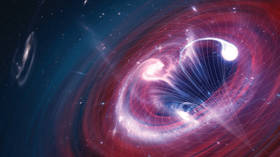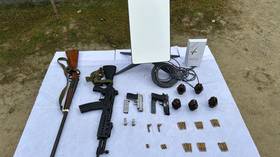Photo confirms what’s at the center of our galaxy

Astronomers have confirmed the supermassive object at the heart of the Milky Way galaxy is indeed a black hole and captured the first-ever images of it using a worldwide network of telescopes. The images were unveiled on Thursday at multiple press conferences by a team of researchers known as the Event Horizon Telescope (EHT) Collaboration.
Known as Sagittarius A, the object at the center of the Milky Way – “invisible, compact and very massive,” as described in a press release published by the European Southern Observatory – was long suspected to be a black hole. However, the images created through linking up a global network of radio telescopes provide direct proof of this hypothesis.
The images show a dark central “shadow” surrounded by a bright ring made up of glowing gasses, the light they produce bent by the black hole’s powerful gravity. The object has four million times the mass of the Sun, and is located 27,000 light years away from our planet.
The visuals were recorded by linking together eight radio observatories around the world to form what the researchers described as “a single ‘Earth-sized’ virtual telescope,” which was then used to observe Sagittarius A for hours at a time on multiple nights in 2017.
The EHT, which includes more than 300 researchers from 80 institutes, previously imaged the black hole M87 at the center of the distant Messier 87 galaxy, publishing those findings in 2019. Sagittarius A is much closer, as well as over 1,000 times smaller and less massive. However, it was significantly more difficult to photograph given the more rapid orbit time of the gases surrounding the Milky Way’s black hole, with EHT scientist Chi-kwan Chan likening the process to “trying to take a clear picture of a puppy quickly chasing its tail.”
Still, the end product looks remarkably similar to its much larger cousin, M87, the EHT’s science council co-chair, Sera Markoff, observed, viewing the similarity as proof that, “General Relativity governs these objects up close, and any differences we see further away must be due to differences in the material that surrounds the black holes.”
The researchers hope to use the data on both black holes to test hypotheses regarding the mysterious objects, from their effect on gravity to how gas behaves in their vicinity, a process that remains poorly-understood but which astronomers believe plays a part in how galaxies form and grow over time.
Accompanying the photographic findings were six papers published in the Astrophysical Journal Letters covering various aspects of the discovery, from the imaging process to the morphology of black holes.













